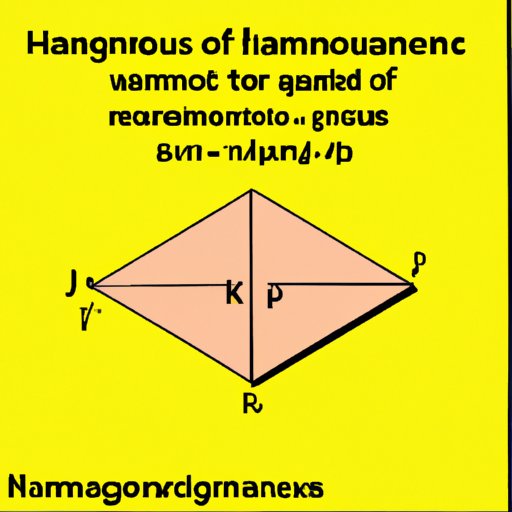
I. Introduction
Have you ever struggled with finding the area of a rhombus? If so, you’re not alone. Many students and adults alike struggle with this concept. This article is written for anyone who wants to learn how to find the area of a rhombus. Whether you’re a high school student studying geometry or an adult looking for a refresher, this article will provide you with all the information you need to master the concept.
II. The Definition of a Rhombus
A rhombus is a four-sided diamond shape with two pairs of equal-length sides and opposite angles that add up to 180 degrees. Unlike a square or rectangle, a rhombus has no right angles, which can make it a bit trickier to work with.

III. The Formula for Finding the Area of a Rhombus
The formula for finding the area of a rhombus is A = (d1 x d2) / 2, where d1 and d2 are the lengths of the diagonals of the rhombus. The area of a rhombus is always equal to half the product of its diagonals.
To use this formula, simply follow these steps:
- Find the lengths of the diagonals of the rhombus.
- Multiply the two diagonals together.
- Divide the product by 2.
For example, let’s say we have a rhombus with diagonals of lengths 6 and 8. To find the area of the rhombus, we would use the formula as follows:
- d1 = 6, d2 = 8
- 6 x 8 = 48
- 48 / 2 = 24
Therefore, the area of the given rhombus is 24 square units.
One common mistake people make when using this formula is to forget to divide the product of the diagonals by 2. Always remember to divide by 2!
IV. Alternative Methods for Finding the Area of a Rhombus
While the formula discussed in Section III is the most common method of finding the area of a rhombus, there are other methods you can use in certain situations. For example, if you know the lengths of all four sides of the rhombus, you can use trigonometry to find the area. Here’s how:
Let’s denote the length of one side of the rhombus as a and the acute angles between adjacent sides as θ. Using trigonometry, we can find the height of the rhombus (the perpendicular distance between opposite sides) as h = a sin(θ). Then the area of the rhombus is A = ah.
An even simpler method involves using the Pythagorean theorem. If we denote the length of one diagonal as d1 and half the length of one side as x, we can use the Pythagorean theorem to find the length of the other diagonal (d2 = √(4x^2 – d1^2)). Then we can plug in d1 and d2 into the formula A = (d1 x d2) / 2 as before.
It’s worth noting, however, that these alternative methods are generally more complex than the standard formula discussed in Section III and should only be used when they offer some advantage over the standard method.
V. Tips and Tricks for Finding the Area of a Rhombus
Here are a few helpful tips to make finding the area of a rhombus easier:
- If you’re given the lengths of the sides of the rhombus, you can use the formula A = (a^2 sin(θ)) / 2, where a is the length of any side and θ is the acute angle between adjacent sides.
- If you’re given the area of the rhombus and one diagonal, you can use A = (d1 x d2) / 2 to find the other diagonal.
- Always remember to double-check your work to make sure you haven’t made any mistakes. Work backwards from your answer and make sure your calculations are correct.
VI. Conclusion
Finding the area of a rhombus may seem daunting at first, but with a little practice and understanding of the formula and alternative methods, it can become second nature. Remember to always double-check your work and use the method that works best for you. With these tips and tricks, you’ll be a pro at finding the area of a rhombus in no time.





